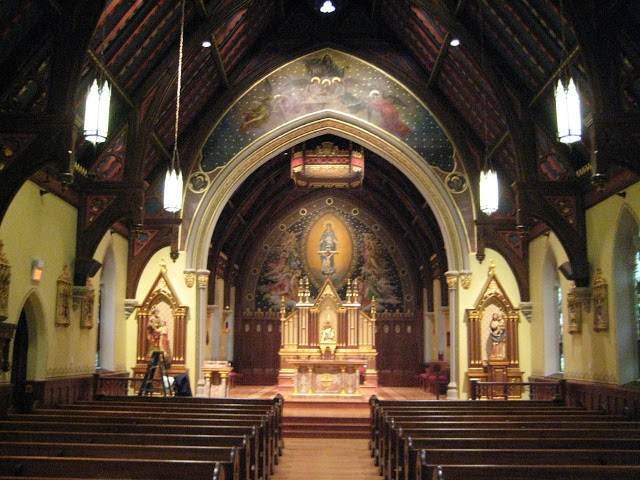The renovated Chapel of the Immaculate Conception at Seton Hall is what I’m talking about. They installed what I presume is a new reredos for the restored central tabernacle, but it doesn’t have an attached altar. Rather the new altar, free standing, is in front of it but clearly designed to match the reredos.
That’s what I am talking about. And the Mass can be celebrated on either side of the freestanding altar:
When you look at the new renovation above, I noticed that the restoration of the side chapels has our Blessed Mother on the right side (Epistle Side) and St. Joseph on the left side or Gospel Side. I was under the impression that if the image of the Sacred Heart or of Christ Himself is used in a church, that it is placed on the Gospel side and the BVM is moved to the right or Epistle side of the Church. But the opposite is above with St. Joseph and St. Mary. Should their placement be reversed above?
But the 1910 look of this chapel, the original look, by the way, has St. Joseph and St. Mary juxtaposed in as in the photo above. Any explanation for this?
For more photos and the story go:




5 comments:
The terms 'epistle side' and 'gospel side' apply only to the altar on which Mass is being celebrated, not to the church as a whole. Nor can they apply to the Novus Ordo, since epistle and gospel are not read at the altar.
Side altars/chapels are located off the nave, often at right angles to it, and traditionally the Lady altar/chapel is on the right hand side of the church.
I was pleased to see that the celebrant was dethroned and the tabernacle restored. What amazed me was in the before pictures much of the original artwork was left intact. The Vatican II iconoclasts typically would paint over it
Using epistle side and gospel side has a corollary in the use of the term the priest's chair side and the ambo side. It makes clear which side one is speaking about no matter which way the person is oriented. When I am at the altar, the right side to me is the left side to the laity. No such confusion with Epistle and Gospel side at least for those knowledgeable of those terms.
Thank you Father! You’ve just numbered me among those knowledgeable of such terms. Some folks look at me funny when I use them, but once I explain the terms to them, they’re usually all...”Oh, thanks. I never heard that before but thank you for enlightening me”, or words to that effect.
Gaudete in Domino Semper!
Neither the ambo nor the 'priest's chair' need be located on opposite sides. If the Tridentine Mass is celebrated versus populum (which was always allowed, but rarely used) then the epistle and gospel side are reversed from the congregation's viewpoint. Service is always from the right, so the credence table is on the left hand side when looking towards the sanctuary; this is normal in the Novus Ordo.
I have visited many churches in Bavaria. The side altars are always well-kept with the requisite linen cloths, cross and candles. It is not unusual to see hand decorated altar cards from the 18th century. Unfortunately those responsible for cleaning sometimes replace them with the epistle side card on the gospel side and vice versa. If no-one's looking I have been known to switch them round.
Post a Comment